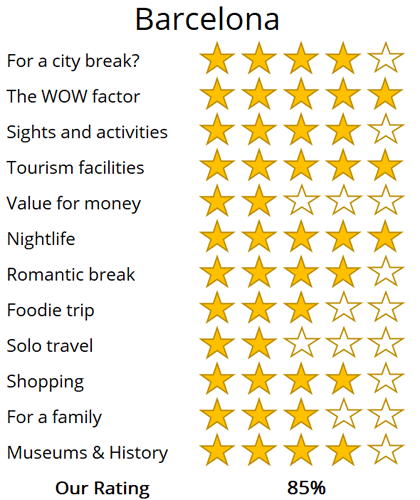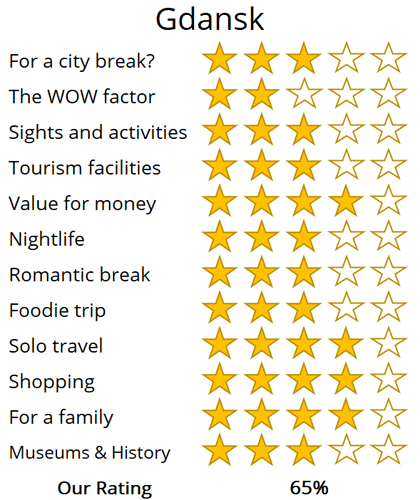WhereToGoForMyHoliday.com
The best destination comparison site!
WhereToGoForMyHoliday.com
The best destination comparison site!
Gdansk or Barcelona, which is better for your holiday in 2024?
Barcelona and Gdansk both offer unique and enticing experiences, but which one should you choose for your city break or holiday?
We recognise the difficulty in making this decision. While there is abundant information available on both destinations, clear guidance on which city better aligns with your travel preferences is often hard to find.
This article aims to provide an impartial comparison of Barcelona and Gdansk, and hopefully help you to choose the best city to visit.
The article is structured into several sections, each of which can be directly accessed through the following links:
• Introduction to the cities
• Scores and ratings
• Which one should I, friends, or family visit?
• When to visit and weather
• Who is the city suited for?
• The perfect 48hours (with map)
• Tourism details (where to stay? airport details?)
Introduction to Barcelona and Gdansk
Barcelona, the pulsating core of Catalonia, exudes a robust and confident identity that's uniquely its own. As a city that's simultaneously youthful, chic, and forward-thinking, it captures the imagination with awe-inspiring landmarks and vibrant culture.
Nestled between the sparkling sea and towering mountains, Barcelona's dynamic and vivacious character thrives. Yet, the ease with which one can retreat to sun-kissed beaches or the rejuvenating mountain landscapes ensures the city never feels confining.
While Barcelona stands as a premier European destination, it's not without its challenges, such as the impact of heavy tourism and sometimes indifferent service. However, for those willing to navigate these aspects, the city's allure is undeniable, offering a blend of cultural richness and natural beauty that continues to enchant visitors from around the world
Salt-washed, industrial-chic and filled with hipsters, Gdansk is one of the most happening cities in Poland. It sits on the edge of the Baltic Sea, proudly showcasing its merchant guilds and mansions, a leftover from the years when this was one of the richest ports in the Hanseatic League.
Like most Polish cities, the focal point is an immersive Old Town (also called the Main City) that beats with life and cafés and boutique shops. Around that's a newer city where the remnants of Communist rule still pop up in the tenement blocks and the famous dockyards where the Solidarity movement heralded the beginning of the end for the USSR in the 1980s.
On top of all the architecture and culture is a vibey bar scene that's powered by a hefty student population. There are clubs and pubs everywhere, from the open-air boats on the quaysides to the hidden basement bars in the old quarter. What's more, Gdansk is the gateway to the Polish coast, with Hel Peninsular and its oat-topped dunes close by, or the resort town of Sopot only a short train ride away.
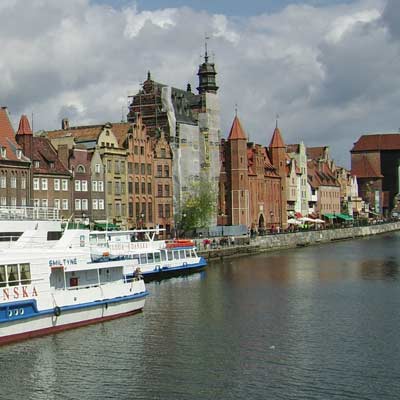
The scenic Długa waterfront in Gdansk
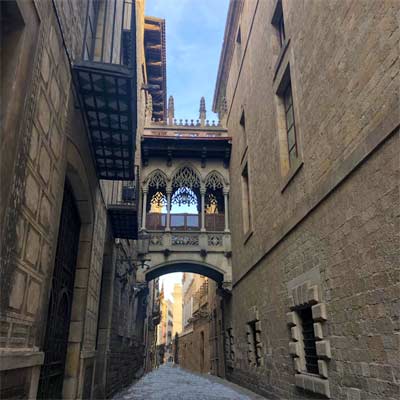
The Barri Gòtic (Gothic Quarter) is one of the most atmospheric areas of Barcelona
High-level summary for Gdansk and Barcelona
Summary
Where would I journey for a personal escape?
Barcelona
Where would I send my parents for a memorable visit?
Barcelona
Where's the ideal destination for my adventurous 19-year-old cousin?
Barcelona
Where should my food-obsessed friend indulge their culinary passions?
Barcelona
Note: The above comparisons are weather-independent and are based on travel during the most opportune times of the year. Details about the ideal travel seasons are elaborated upon later in this article.
In the sections that follow, you'll find a comprehensive comparison between these two fascinating cities. This includes recommendations on the duration of stay, the best times to visit, and tailored 48-hour itineraries for each city.
The final segment delves into practicalities for your travels, such as the best airport to fly into, the optimal districts for your accommodation, and insider tips, for when you come to explore the city.
We hope that you find all of this information useful, in planning your next exciting trip!
Destination details
How long to spend each city?
Barcelona can be fully seen with two intense days of sightseeing, but if you include the beaches, the mountain viewpoints and a more leisurely pace, this leads to the conventional four-day visit.
A trip could be extended by visiting the picturesque Montserrat Monastery and mountains or the attractive coastal town of Sitges. Barcelona is much more suited for a short city break than a longer holiday, and does lack the diversity of day trips as with other destinations.
Gdansk can be done in just a couple of days, but don't expect that to be enough to do everything. You'll likely want to linger longer, if only to beachcomb the Baltic coast, explore the other corners of the Tri-City (Gdansk is just one of three individual towns that are joined together), and sample as many of the cool hipster bars as you can.
Still, city breaks are very much doable here. Just 48 or 72 hours is ample for checking off the historic sights in the centre, the fascinating dockyards monuments, and to get a feel for the unique fusion of Slavic-Germanic architecture that abounds. Expect to do a lot of walking, though, and be ready to hop on inner-city trains and trams to get from A to B.
During the summertime, you could opt to do as thousands of Polish locals do and extend your Gdansk holiday to a week or two. That'll let you head out to the coast and the beaches. They can be surprisingly stunning, especially along the breezy Hel headland.

The flamboyant Park Guell, colourful mosaics and whimsical buildings all designed by Barcelona great designer Antoni Gaudí
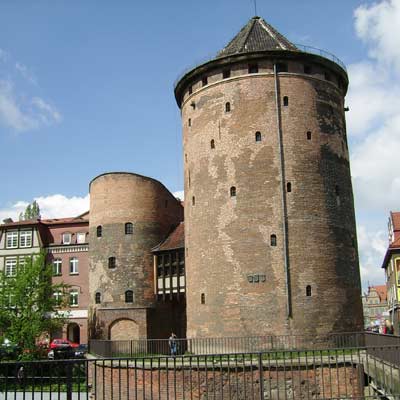
The Stągwie Mleczne was the ancient gateway to the southern side of Gdansk
Gdansk is surely at its best in the warmer months. Between May and September is when most travellers come. They get to enjoy all the al fresco bars along the old port. They can wander the Old Town without worrying (too much, at least) about rain. They can hit the open-air terraces to taste pierogi dumplings. The weather is a little milder than inland Poland thanks to the tempering effect of the Baltic Sea. Average highs in July are in the low 20s, but that's enough to bring crowds to the beaches of Sopot and the north coast.
The winter in Gdansk can be brutal. The Baltic magnetises icy storms and cold winds across the shoreline and the city. It's a time to get cosy in cute cafes and sip warm beers (yes, that's a thing here), but be certain to pack the thermal leggings and snow coats.
Barcelona is almost a year-round destination, and the best time of year to visit is either early spring or later autumn as this is outside of the peak season, but the weather is still pleasant.
The peak tourist season is July and August, and we suggest Barcelona is best avoided, as it is just too hectic and crowded. The weather is suitable for spending time on the beaches from May until October. The winter months are cooler and possibly wet but there is a less hectic pace around the city.
Barcelona is flashy, energetic and modern. The city has vibrant tourist attractions, without the stuffy atmosphere of many other historic destinations. It generally appeals more to the younger visitor with its heady mix of nightlife, beaches and Instagram ready tourist attractions.
It should be noted that Barcelona is not a cheap city, being the most expensive city in Spain. Barcelona is great for a short stay or a one-day visit, such as from a cruise ship.
Gdansk has got loads going for it on the travel front. Melding enthralling medieval history with sobering tales of wartime and the proud trade union movement, it's a gem for those looking to unravel the history of Central-Eastern Europe. Shoppers get to delve into Amber shops galore – the city is hailed as one of the best places in the world to buy the glowing fossil. Hedonists get everything from basement bars to wild clubs in old bunkers that stay open all night. Sightseers need only look to the historic Old Town and its grand churches and squares.
Adding to all that, Gdansk has beaches. A quick train to Sopot will reveal one of the nicest in the region, with a long pier that juts out into the Baltic. A little further and you can get to Puck, which sits at the base of what is arguably Poland's finest length of coastline.
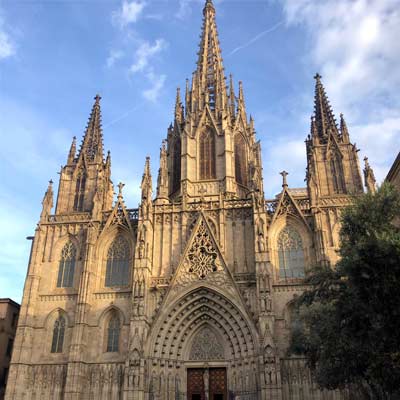
The cathedral of Barcelona is dedicated to Saint Eulalia, and in the adjoining cloister are the 13 white geese commemorating her young martyr death at 13
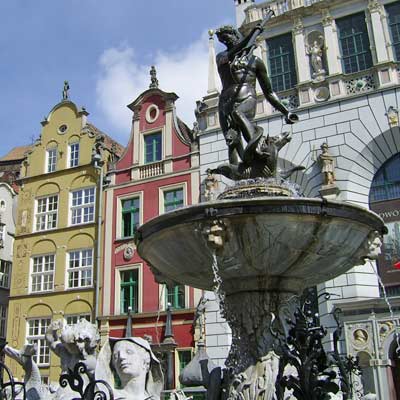
Neptune's Fountain in the historic centre of Gdansk
Barcelona
Barcelona is a tremendous destination for a 48-hours, and excels as a short-stay destination. Below is an interactive map for 48 hours in Barcelona; day 1 is highlighted in green and day 2 in yellow, with optional sights marked grey.
The first morning would start on the La Rambla the authentic shopping street, which is so popular with tourists and locals alike. For the middle of the day explore the Gothic Quarter, which contains the cathedral and Picasso museum.
For the final part of the head towards the harbour and the lively Barceloneta district, that lies the beaches. For the evening both Gothic Quarter or Barceloneta boasts restaurants, atmosphere and entertainment.

The cable car up to Montjuïc Castle provides wonderful views over Barcelona
For the second day begin by visiting the awe-inspiring Sagrada Familia basilica, with is whimsical towers, intricate carvings and masterpiece of Antoni Gaudí. The theme of Gaudí continues with the next sight, the Parc Guell, which was designed by him and includes delightful mosaic-covered buildings and wonderful views of the city.
The final area to discover is Montjuï, where you can ride the cable car to a stunning or visit the MNAC museum housed in the grand Palau Nacional.
The finale for your time in Barcelona is the inspiring Magic Fountain light show, held at the fountain near the MNAC museum (Wed-Sun peak season).

Did we mention Barcelona has beaches, and that they are amazing!
48hours in Gdansk
Gdansk has big-name sights like the iconic dockyards and its Old Town. But it also has secrets up its millennia-old sleeve. This 48-hour itinerary covers both, with a little bit of partying and beachside living thrown in for good measure…
The interactive map below shows a suggested route for the 48 hours in Gdansk, with day 1 highlighted in green and day two in yellow.
Day 1: Make for Cafe Libertas for breakfast. It's a popular spot with fruit bowls and artisan coffee that will fuel you up right in the heart of the Old Town. Stepping outside the door, you'll find quaint Chlebnicka street, which you can stroll between grand townhouses with Flemish-inspired façades.
At one end is Chlebnicka Gate, still flaunting its original medieval crest from 1450. Beyond is the riverside and the iconic Żuraw Crane. Now a branch of the National Maritime Museum, it's a great detour to make if you want to learn all about the history of shipbuilding in Gdansk.
Delve back into the maze of streets to the west and try to find the St. Mary's Church. It shouldn't be difficult – it's among the three largest brick-built churches on the planet! Past that is bustling Długa. The main drag of the city, it's awash with amber shops, bars, eateries and more.
Stop to sample some pierogi dumplings or grab a beer, and then move on to lovely Long Market square. That's where the famous statue of Neptune beckons, hemmed in by pastel-painted guilds. As evening arrives, return to Długa or Piwna street for basement bars that gush with vodka and cheap beer.
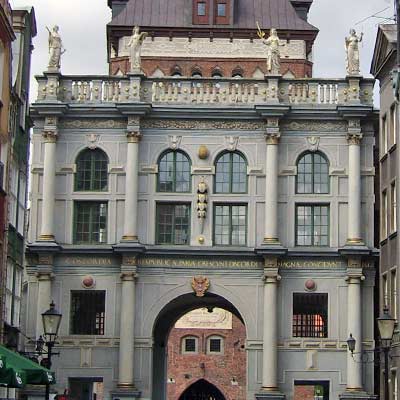
The Złota Brama (Golden Gate) is lined with figures depicting the qualities of the ideal citizen
Day 2: Morning of Day 2 takes you out to the legendary Gdansk Shipyards. If you haven't heard of these already, then buckle in for a history lesson in the fall of Communism. It was here, in 1980, that the powerful Solidarity movement first took route under the leadership of Lech Wałęsa. It would go on to fuel revolutions across the Eastern Bloc, which finished with the fall of the Berlin Wall and the end of Russian dominion in Europe.
There's nowhere better to uncover all that than at the European Solidarity Centre. A visit is likely to take a few hours, especially if you want to drop by the striking Monument to the Fallen Shipyard Workers of 1970 next door. For the afternoon, it's time to explore the Tri-City.
That means hopping on the SKM railway line from Gdańsk Główny. The ride to Sopot is only 15 minutes. It takes you to a lively resort area that's positively brimming with bars and eateries. It's also on the beach, so you might want to spend the evening here, moving between the music venues to famous Sopot Pier.

The European Solidarity Centre commemorates the Polish civil resistance and trade union which began in the Polish shipyards and ultimately led to the collapse of the communism in the USSR

Sopot has a beautiful beach and is an enjoyable destination during the summer season
If you can find decent accommodation, then Barcelona is enjoyable for a city break. The main airport of Barcelona is 17km from the city centre and connected by train, but the low-cost airlines may use the very distant Barcelona-Reus (110km south) or Barcelona-Girona (90km north). Neither airport is good for a short city-break, as so much time will be waste travelling.
Accommodation for Barcelona is always in high demand, and you will typically end up paying much more than you originally planned before making any reservations. The summer months can be a real challenge to find good accommodation – book well in advance.

The Sagrada Família is the standout attraction of Barcelona
Once in Barcelona all of the main sights are close and can be easily walked. The standard of food and service at restaurants in the tourist areas varies dramatically, it’s always advisable to check reviews first.
Getting to Gdansk by plane is easy because of the countless short-haul and low-cost carriers that now fly into the local Lech Wałęsa Airport. A mere nine miles outside of the centre, you can get to the terminals on the 210 bus from the main train station. There are often problems with scam taxi fares to and from the airport, so always agree a rough price beforehand (the normal rate is between 60-80 PLN).
Gdansk's Main City is a joy to walk. The streets of Długa and the quays are all connected by loads of hidden alleys and paths. It might pay to have a tourist map at hand because getting lost is almost inevitable if it's your first time in town.
To travel to the beaches, the shipyards, and Sopot, you'll need to make use of the trams and inter-city SKM trains. The former cost 3.2 PLN per ride. Tickets are available from vending machines at most stations. Be sure to validate as you board.
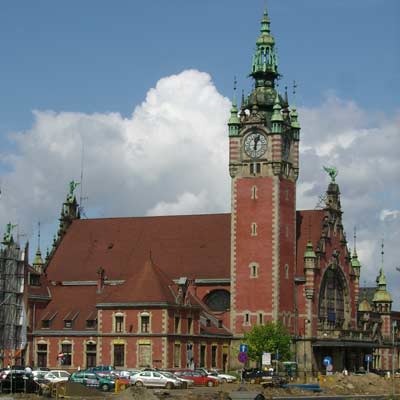
Gdansk Glowny - the main train station of Gdansk
The best location for a hotel in Gdansk is certainly in the Old Town area. There, you'll get boutique lodgings and stylish aparthotels set in centuries-old buildings. An alternative for those who favour beaches and nightlife would be to bed down in Sopot, where resort hotels with swimming pools and stylish restaurants are the norm.
Gdansk is among the most liberal and welcoming of Polish cities. It's got a vibrant LGBT scene and incidents of racism and crime are relatively rare. Still, there are still tensions in Poland and it's wise to be on your guard, especially if out at night in the bars of the Old Town.

oh we were stuck in the airport!

Copenhagen was a bit expensive...

All we did was drink beer in Brussels...

Muncih was crazy

And we got so burnt!

Remeber that night in Rome

oh we were stuck in the airport

So much fun kayaking

Berlin and that group from Austria!

There was such a view from that church

And we got so burnt!

Munich was eventful, wasn't it!

Such a view from that cathedral in Florence

Lisbon was such so much fun

Last summer was so much fun .... x

Remeber that night in Rome

Lisbon was such so much fun

Such a view from that cathedral in Florence

Munich was eventful, wasn't it!

And we got so burnt!

Remeber that night in Rome

All we did was drink beer in Brussels...

Berlin and that group from Austria!

Can't wait to go back to Dubrovnik

Remember that boat ride in Prague

Copenhagen was a bit expensive...
